Extrapolation of Digital Soil Mapping Approaches for Soil Organic Carbon Stock Predictions in an Afromontane Environment
Abstract
:1. Introduction
2. Materials and Methods
2.1. Study Area
2.2. Mapping and Modeling Methods
2.2.1. SoLIM Rule-Based
2.2.2. SoLIM Sample-Based
2.2.3. Random Forest
2.2.4. Least Absolute Shrinkage and Selection Operator
2.2.5. Regression Kriging with Cubist Models
2.2.6. Universal Kriging
2.3. Environmental Covariates
2.4. Field Design and Sampling
2.5. Laboratory Analysis
2.5.1. Bulk Density
2.5.2. Soil Carbon Content and Stock
2.6. Statistical Indicators
3. Results
3.1. Carbon Content and Stock, Bulk Density, and Rock Fraction
3.2. Analysis of Environmental Covariates
3.3. Evaluation of Models
3.4. Total SOC of Catchments
4. Discussion
4.1. Relationship between SOC and Bulk Density
4.2. Covariate Importance
4.3. Extrapolation Success
4.4. Comparison of Maps and Trends
5. Conclusions
Author Contributions
Funding
Data Availability Statement
Acknowledgments
Conflicts of Interest
References
- Ellili, Y.; Walter, C.; Michot, D.; Pichelin, P.; Lemercier, B. Mapping soil organic carbon stock change by soil monitoring and digital soil mapping at the landscape scale. Geoderma 2019, 351, 1–8. [Google Scholar] [CrossRef]
- Lorenz, K.; Lal, R. Soil Organic Carbon: An Appropriate Indicator to Monitor Trends of Land and Soil Degradation within the SDG Framework; Umweltbundesamt: Dessau-Roßlau, Germany, 2016; pp. 14–22. [Google Scholar]
- Schulze, R.E.; Schütte, S. Mapping soil organic carbon at a terrain unit resolution across South Africa. Geoderma 2020, 373, 114447. [Google Scholar] [CrossRef]
- Wang, M.; Yang, W.; Wu, N.; Wu, Y.; Lafleur, P.; Lu, T. Patterns and drivers of soil carbon stock in southern China’s grasslands. Agric. For. Meteorol. 2019, 276, 107634. [Google Scholar] [CrossRef]
- Muñoz, M.A.; Faz, A.; Zornoza, R. Carbon stocks and dynamics in grazing highlands from the Andean Plateau. Catena 2013, 104, 136–143. [Google Scholar] [CrossRef]
- Conant, R.T. Challenges and Opportunities for Carbon Sequestration in Grassland Systems: A Technical Report on Grassland Management and Climate Change Mitigation. In Integrated Crop Management; FAO Publishing: Rome, Italy, 2010; Volume 9, pp. 5–22. [Google Scholar]
- Otte, J.; Pica-Ciamarra, U.; Morzaria, S. A comparative overview of the livestock-environment interactions in Asia and Sub-Saharan Africa. Front. Vet. Sci. 2019, 6, 37. [Google Scholar] [CrossRef] [Green Version]
- van Zijl, G.M.; Bouwer, D.; van Tol, J.J.; Le Roux, P.A.L. Functional digital soil mapping: A case study from Namarroi, Mozambique. Geoderma 2014, 219, 155–161. [Google Scholar] [CrossRef]
- McBratney, A.B.; Mendonça Santos, M.L.; Minasny, B. On digital soil mapping. Geoderma 2003, 117, 3–52. [Google Scholar] [CrossRef]
- Adhikari, K.; Hartemink, A.E.; Minasny, B.; Bou Kheir, R.; Greve, M.B.; Greve, M.H. Digital mapping of soil organic carbon contents and stocks in Denmark. PLoS ONE 2014, 9, 105519. [Google Scholar] [CrossRef]
- Simón, N.; Montes, F.; Díaz-Pinés, E.; Benavides, R.; Roig, S.; Rubio, A. Spatial distribution of the soil organic carbon pool in a Holm oak dehesa in Spain. Plant Soil 2013, 366, 537–549. [Google Scholar] [CrossRef] [Green Version]
- Yang, R.M.; Zhang, G.L.; Liu, F.; Lu, Y.Y.; Yang, F.; Yang, F.; Yang, M.; Zhao, Y.G.; Li, D.C. Comparison of boosted regression tree and random forest models for mapping topsoil organic carbon concentration in an alpine ecosystem. Ecol. Indic. 2016, 60, 870–878. [Google Scholar] [CrossRef]
- Gomes, L.C.; Faria, R.M.; de Souza, E.; Veloso, G.V.; Schaefer, C.E.G.; Fernandes Filho, E.I. Modeling and mapping soil organic carbon stocks in Brazil. Geoderma 2019, 340, 337–350. [Google Scholar] [CrossRef]
- Seboko, K.R.; Kotze, E.; van Tol, J.; van Zijl, G. Characterization of Soil Carbon Stocks in the City of Johannesburg. Land 2021, 10, 83. [Google Scholar] [CrossRef]
- Matinfar, H.R.; Maghsodi, Z.; Mousavi, S.R.; Rahmani, A. Evaluation and Prediction of Topsoil organic carbon using Machine learning and hybrid models at a Field-scale. Catena 2021, 202, 105258. [Google Scholar] [CrossRef]
- Grinand, C.; Arrouays, D.; Laroche, B.; Martin, M.P. Extrapolating regional soil landscapes from an existing soil map: Sampling intensity, validation procedures, and integration of spatial context. Geoderma 2008, 143, 180–190. [Google Scholar] [CrossRef]
- Du, L.; McCarty, G.W.; Li, X.; Rabenhorst, M.C.; Wang, Q.; Lee, S.; Hinson, A.L.; Zou, Z. Spatial extrapolation of topographic models for mapping soil organic carbon using local samples. Geoderma 2021, 404, 115290. [Google Scholar] [CrossRef]
- Kotzé, J. Quantifying Soil Carbon Stocks in Alpine Areas of the Maloti-Drakensberg Mountains Using Digital Soil Mapping Approaches. Master’s Thesis, University of the Free State, Bloemfontein, South Africa, 2022; pp. 43–74. [Google Scholar]
- Finch, J.M.; Hill, T.R.; Meadows, M.E.; Lodder, J.; Bodmann, L. Fire and montane vegetation dynamics through successive phases of human occupation in the northern Drakensberg, South Africa. Quat. Int. 2022, 611, 66–76. [Google Scholar] [CrossRef]
- Mokotjomela, T.; Schwaibold, U.; Pillay, N. Does the ice rat Otomys sloggetti robertsi contribute to habitat change in Lesotho? Acta Oecol. 2009, 35, 437–443. [Google Scholar] [CrossRef]
- Cole, M.J.; Bailey, R.M.; Cullis, J.D.; New, M.G. Spatial inequality in water access and water use in South Africa. Water Policy 2018, 20, 37–52. [Google Scholar] [CrossRef]
- Carbutt, C. The Drakensberg Mountain Centre: A necessary revision of southern Africa’s high-elevation centre of plant endemism. S. Afr. J. Bot. 2019, 124, 508–529. [Google Scholar] [CrossRef]
- Zhu, A.X.; Burt, J.E.; Du, F. SoLIM Solutions Help Manual: For SoLIM Solution 2016. 2015. Available online: https://lreis2415.github.io/SoLIMSolutions/software.html (accessed on 28 January 2022).
- Zhu, A.X.; Hudson, B.; Burt, J.; Lubich, K.; Simonson, D. Soil mapping using GIS, expert knowledge, and fuzzy logic. Soil Sci. Soc. Am. J. 2001, 65, 1463–1472. [Google Scholar] [CrossRef] [Green Version]
- Malone, B.P.; Minasny, B.; McBratney, A.B. Using R for Digital Soil Mapping, 1st ed.; Springer International Publishing: Cham, Switzerland, 2017; pp. 117–149. [Google Scholar]
- Nussbaum, M.; Spiess, K.; Baltensweiler, A.; Grob, U.; Keller, A.; Greiner, L.; Schaepman, M.E.; Papritz, A. Evaluation of digital soil mapping approaches with large sets of environmental covariates. Soil 2018, 4, 1–22. [Google Scholar] [CrossRef] [Green Version]
- Kerr, D.D.; Ochsner, T.E. Soil organic carbon more strongly related to soil moisture than soil temperature in temperate grasslands. Soil Sci. Soc. Am. J. 2020, 84, 587–596. [Google Scholar] [CrossRef] [Green Version]
- Lamichhane, S.; Kumar, L.; Wilson, B. Digital soil mapping algorithms and covariates for soil organic carbon mapping and their implications: A review. Geoderma 2019, 352, 395–413. [Google Scholar] [CrossRef]
- Minasny, B.; McBratney, A.B. A conditioned Latin hypercube method for sampling in the presence of ancillary information. Comput. Geosci. 2006, 32, 1378–1388. [Google Scholar] [CrossRef]
- Yang, L.; Li, X.; Shi, J.; Shen, F.; Qi, F.; Gao, B.; Chen, Z.; Zhu, A.X.; Zhou, C. Evaluation of conditioned Latin hypercube sampling for soil mapping based on a machine learning method. Geoderma 2020, 369, 114337. [Google Scholar] [CrossRef]
- Liang, P.; Qin, C.Z.; Zhu, A.X.; Hou, Z.W.; Fan, N.Q.; Wang, Y.J. A case-based method of selecting covariates for digital soil mapping. J. Integr. Agric. 2020, 19, 2127–2136. [Google Scholar] [CrossRef]
- Clifford, D.; Payne, J.E.; Pringle, M.J.; Searle, R.; Butler, N. Pragmatic soil survey design using flexible Latin hypercube sampling. Comput. Geosci. 2014, 67, 62–68. [Google Scholar] [CrossRef]
- Soil Classification Working Group. Soil classification: A Natural and Anthropogenic System for South Africa; ARC-Institute for Soil, Climate and Water: Pretoria, South Africa, 2018. [Google Scholar]
- Razakamanarivo, R.H.; Grinand, C.; Razafindrakoto, M.A.; Bernoux, M.; Albrecht, A. Mapping organic carbon stocks in eucalyptus plantations of the central highlands of Madagascar: A multiple regression approach. Geoderma 2011, 162, 335–346. [Google Scholar] [CrossRef]
- Jabro, J.D.; Stevens, W.B.; Iversen, W.M. Comparing two methods for measuring soil bulk density and moisture content. Open J. Soil Sci. 2020, 10, 233–243. [Google Scholar] [CrossRef]
- Ramifehiarivo, N.; Brossard, M.; Grinand, C.; Andriamananjara, A.; Razafimbelo, T.; Rasolohery, A.; Razafimahatratra, H.; Seyler, F.; Ranaivoson, N.; Rabenarivo, M.; et al. Mapping soil organic carbon on a national scale: Towards an improved and updated map of Madagascar. Geoderma Reg. 2017, 9, 29–38. [Google Scholar] [CrossRef]
- Zhang, Y.; Ai, J.; Sun, Q.; Li, Z.; Hou, L.; Song, L.; Tang, G.; Li, L.; Shao, G. Soil organic carbon and total nitrogen stocks as affected by vegetation types and altitude across the mountainous regions in the Yunnan Province, south-western China. Catena 2021, 196, 104872. [Google Scholar] [CrossRef]
- Salehi Rizi, F.; Granitzer, M. Properties of vector embeddings in social networks. Algorithms 2017, 10, 109. [Google Scholar] [CrossRef] [Green Version]
- Dorji, T.; Odeh, I.O.; Field, D.J.; Baillie, I.C. Digital soil mapping of soil organic carbon stocks under different land use and land cover types in montane ecosystems, Eastern Himalayas. For. Ecol. Manag. 2014, 318, 91–102. [Google Scholar] [CrossRef]
- du Preez, C.C.; van Huyssteen, C.W.; Mnkeni, P.N. Land use and soil organic matter in South Africa 2: A review on the influence of arable crop production. S. Afr. J. Sci. 2011, 107, 1–8. [Google Scholar] [CrossRef] [Green Version]
- Malone, B.P.; Jha, S.K.; Minasny, B.; McBratney, A.B. Comparing regression-based digital soil mapping and multiple-point geostatistics for the spatial extrapolation of soil data. Geoderma 2016, 262, 243–253. [Google Scholar] [CrossRef]
- Angelini, M.E.; Kempen, B.; Heuvelink, G.B.M.; Temme, A.J.; Ransom, M.D. Extrapolation of a structural equation model for digital soil mapping. Geoderma 2020, 367, 114226. [Google Scholar] [CrossRef]
- Don, A.; Schumacher, J.; Scherer-Lorenzen, M.; Scholten, T.; Schulze, E.D. Spatial and vertical variation of soil carbon at two grassland sites—Implications for measuring soil carbon stocks. Geoderma 2007, 141, 272–282. [Google Scholar] [CrossRef]
- Job, N.; Mbona, N.; Dayaram, A.; Kotze, D.C. Guidelines for Mapping Wetlands in South Africa, 1st ed.; SANBI Biodiversity Series 28; SANBI Biodiversity: Pretoria, South Africa, 2018; pp. 28–40. [Google Scholar]
- Mathinya, N.V.; Clark, V.R.; van Tol, J.J.; Franke, A.C. Resilience and Sustainability of the Maloti-Drakensberg Mountain System: A Case Study on the Upper uThukela Catchment. In Human-Nature Interactions: Exploring Nature’s Values Across Landscapes; Misiune, I., Depellegrin, D., Egarter, V.L., Eds.; Springer International Publishing: Cham, Switzerland, 2022; pp. 155–167. [Google Scholar]
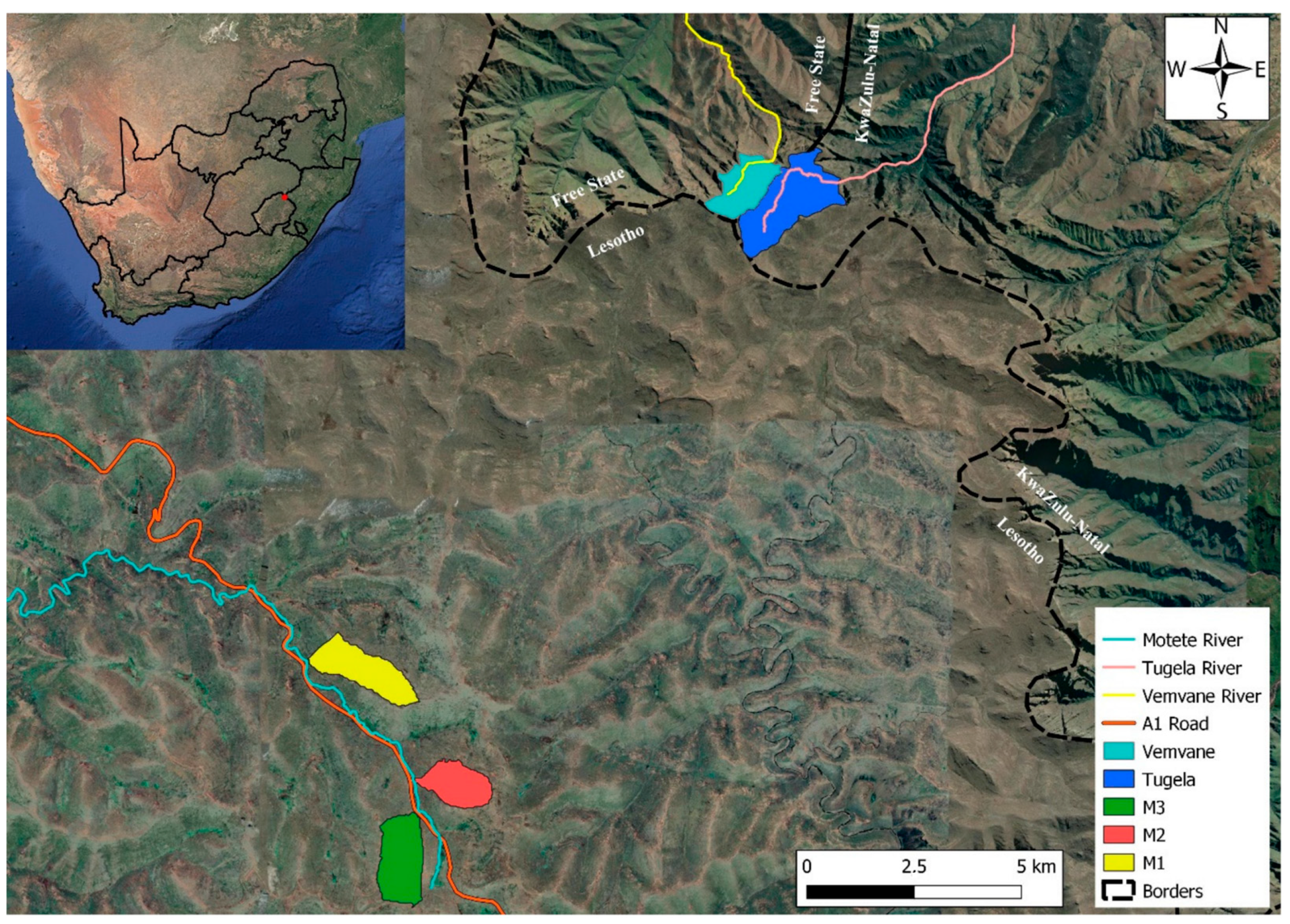
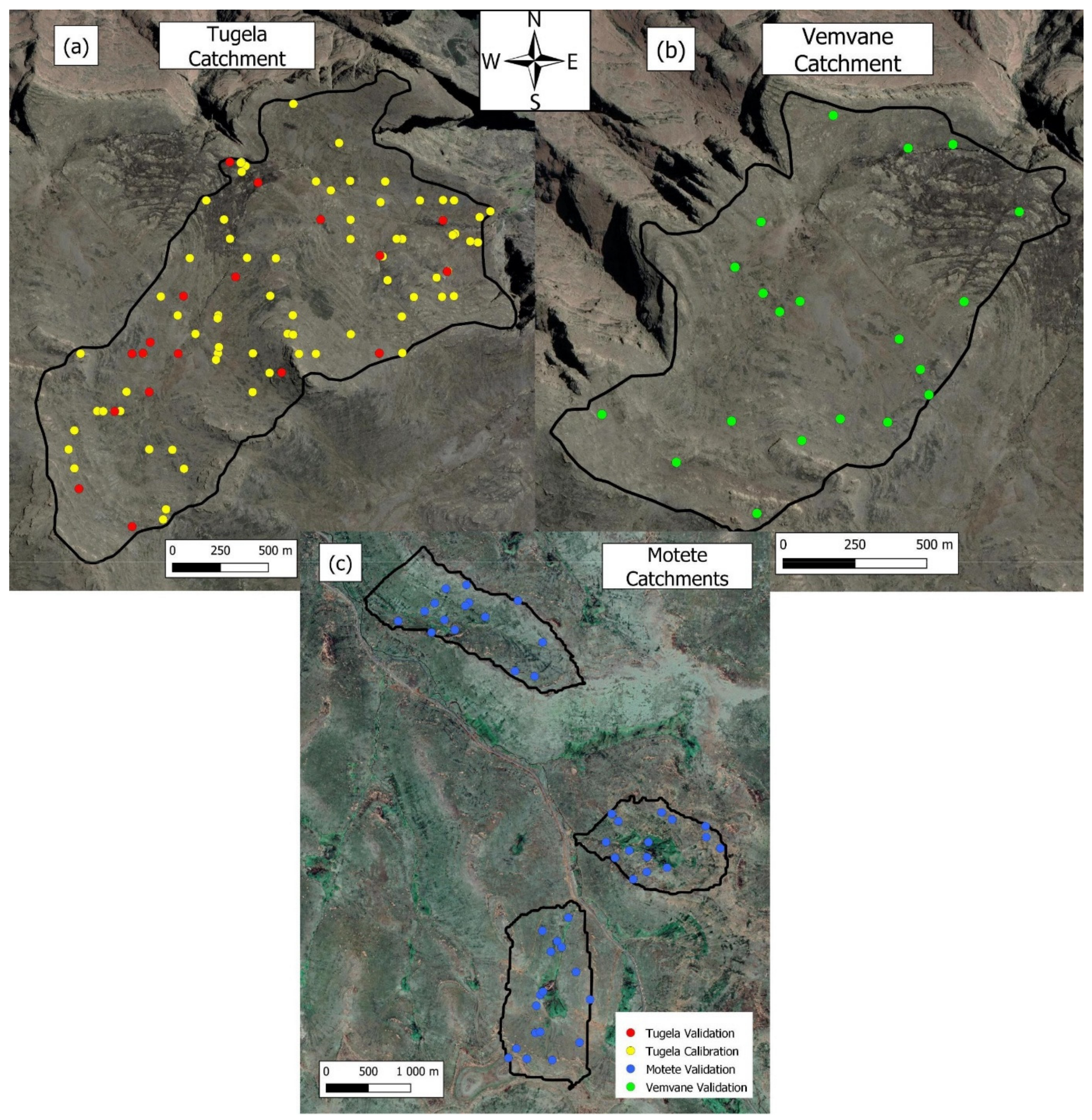
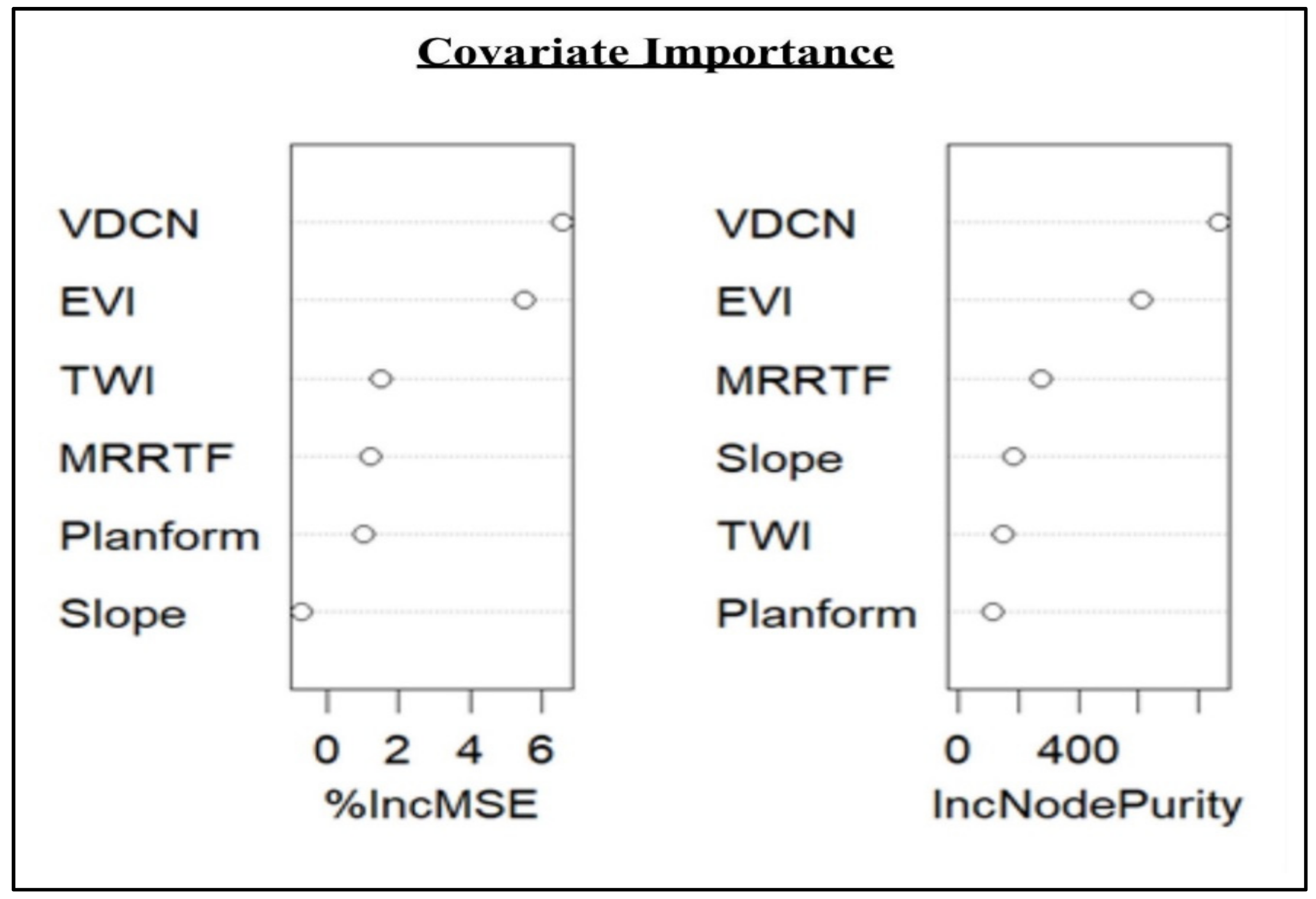
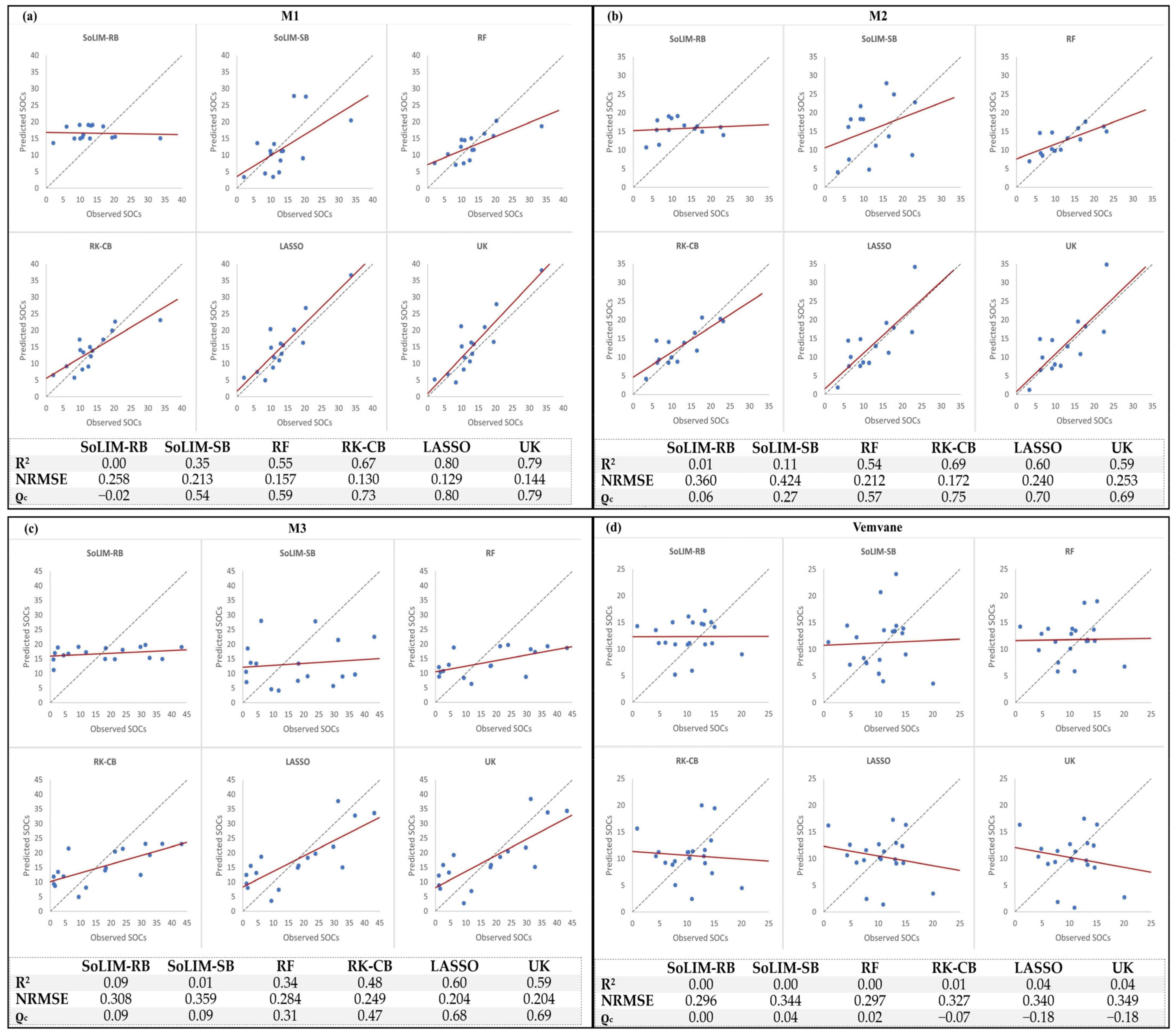

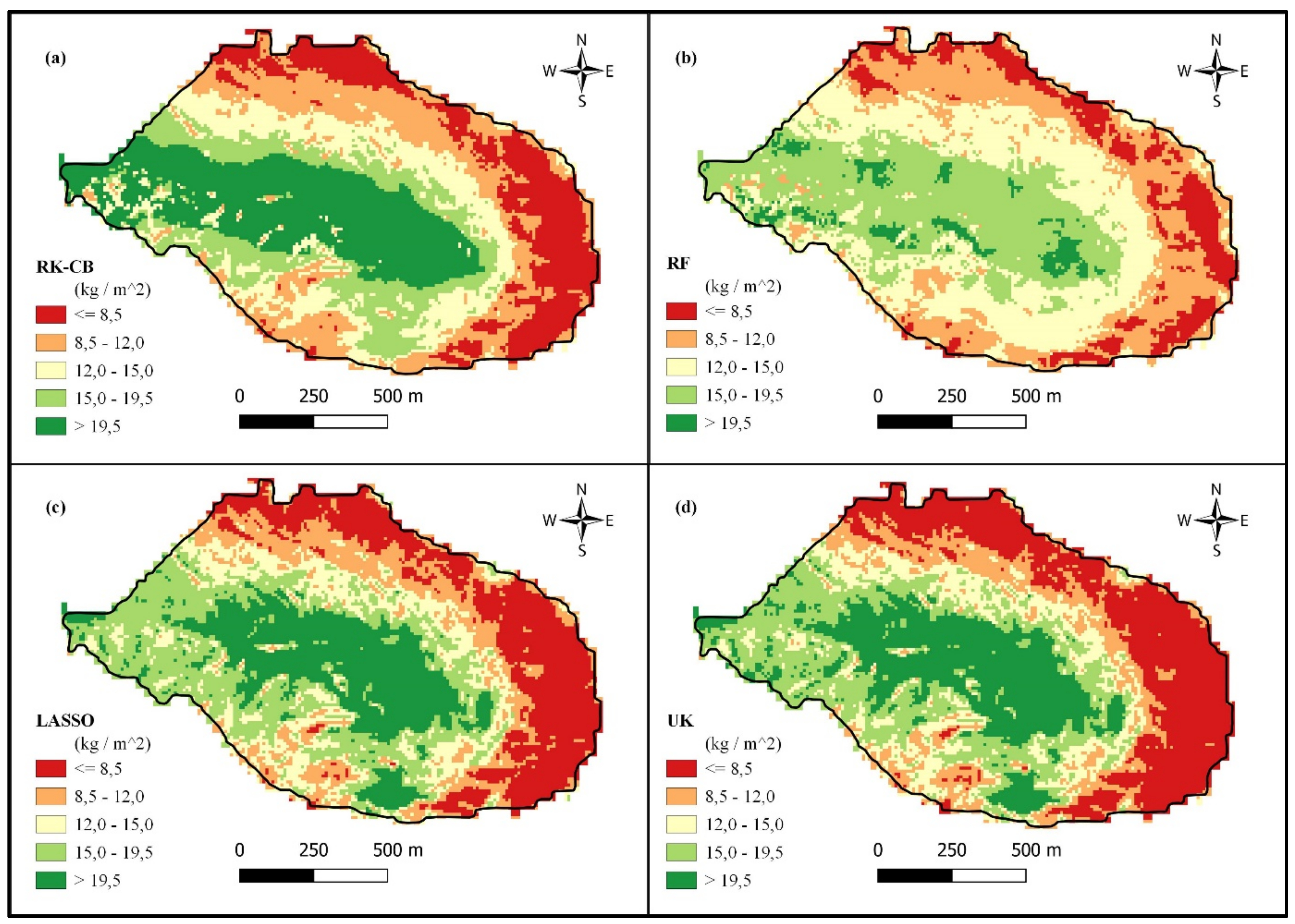
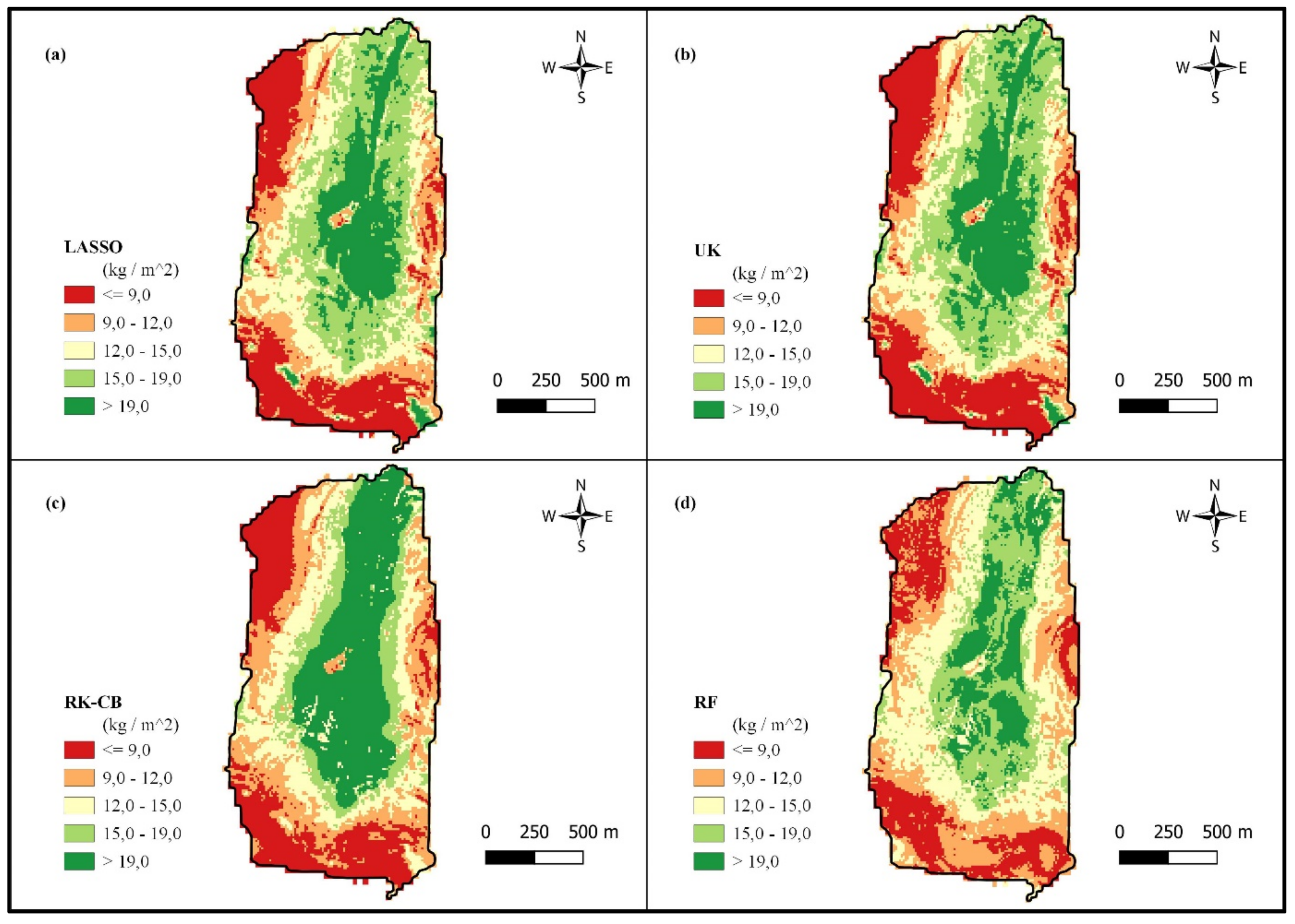
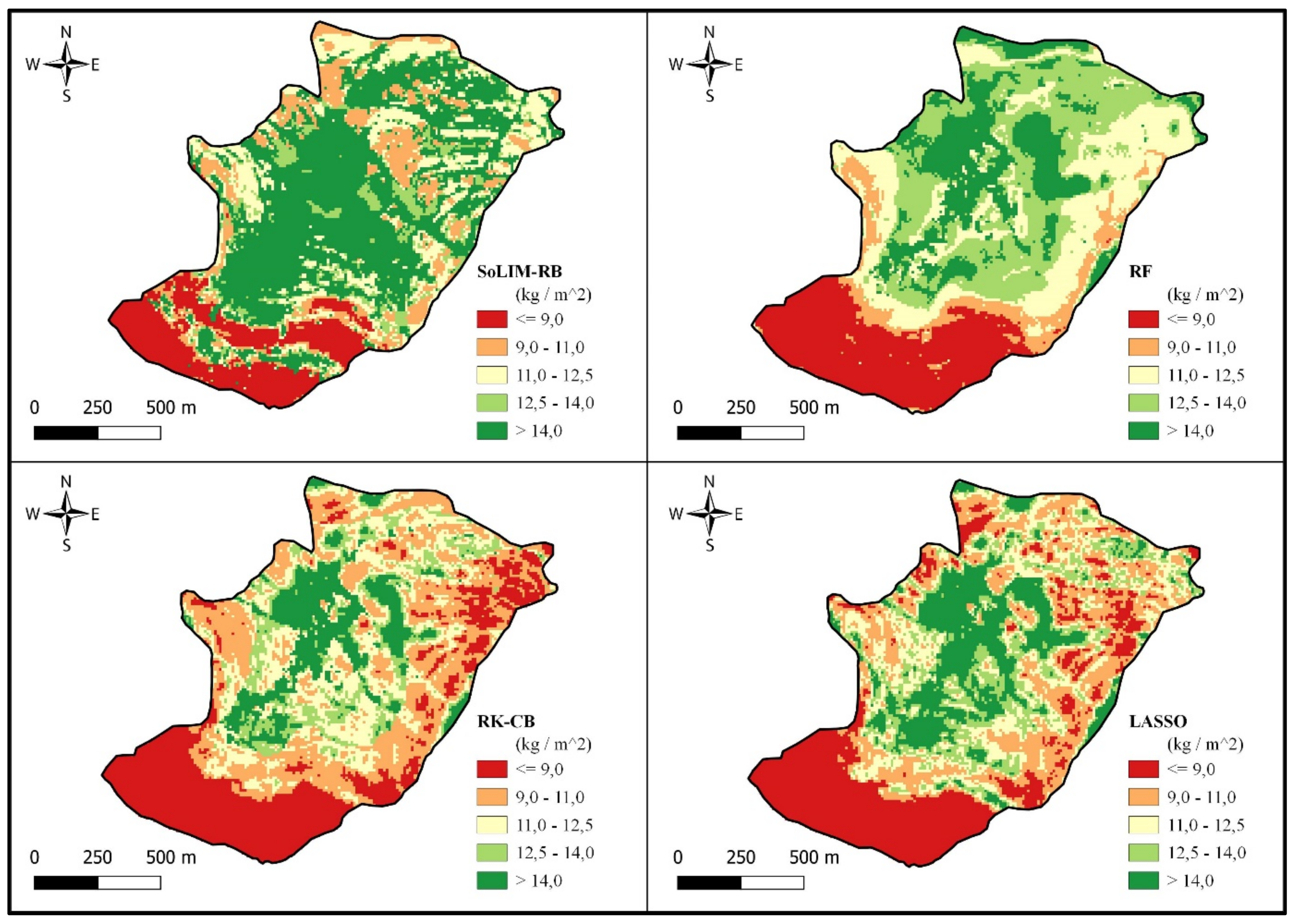
| Soil Association | Soil-Landscape Rules | ||||
|---|---|---|---|---|---|
| Vertical Distance to Channel Network (VDCN) | Slope Percentage | Topographic Wetness Index (TWI) | Multiresolution Index Valley Bottom Flatness (MrVBF) | Normalized Difference Vegetation Index (NDVI) | |
| Organic | <7 m | <8% | >12 | >2 | >0.16 |
| Shallow Humic (Hs) | <35 m | 8–13% | 7–12 | 0.3–2 | >0.16 |
| Deep Humic (Hd) | 35–60 m | 13–18% | 7–12 | 0.01–1 | >0.16 |
| Deep Orthic (Od) | 35–80 m | 18–25% | <7 | 0.01–1 | <0.16 |
| Shallow Orthic (Os) | >60 m | >25% | <7 | <0.01 | <0.16 |
| Covariates | Type | Description | Required |
|---|---|---|---|
| Enhanced vegetation index (EVI) | Vegetation | Vegetation index with canopy background and atmospheric corrections. | Multispectral scanner |
| Multiresolution index of ridge top flatness (MrRTF) | Morphometry | Identify higher areas of a landscape and characterize its flatness. | DEM |
| Planform curvature | Morphometry | Characterize flow as either convergence or divergence. | DEM |
| TWI | Hydrology | Quantifies the influence of topography on hydrological processes. | Slope and catchment area |
| Slope | Morphometry | The measurement of steepness or the degree of inclination. | DEM |
| VDCN | Hydrology | An interpolated value of a location for the height above a river network. | DEM and channel network |
| Number of Samples (n) | Depth (cm) | Bulk Density (g cm−3) | Rock Fraction | SOC Content (%) | SOCs (kg m−2) | |
|---|---|---|---|---|---|---|
| Tugela | 90 | 25 ± 13 | 0.96 ± 0.19 | 0.11 ± 0.06 | 6.26 ± 2.09 | 12.66 ± 7.02 |
| Vemvane | 20 | 28 ± 14 | 0.89 ± 0.09 | 0.10 ± 0.04 | 4.17 ± 2.03 | 10.43 ± 4.48 |
| M1 | 15 | 31 ± 16 | 0.85 ± 0.10 | 0.08 ± 0.03 | 7.90 ± 4.31 | 13.37 ± 7.33 |
| M2 | 14 | 34 ± 21 | 0.88 ± 0.14 | 0.08 ± 0.03 | 5.75 ± 2.87 | 12.23 ± 6.19 |
| M3 | 17 | 35 ± 27 | 0.87 ± 0.08 | 0.11 ± 0.03 | 6.58 ± 2.75 | 17.29 ± 13.88 |
| Covariates | Catchments | |||||
|---|---|---|---|---|---|---|
| Tugela | Vemvane | M1 | M2 | M3 | ||
| Planform | Min ± Max Mean ± SD Kurtosis Skewness | −0.002 ± 0.004 0.000 ± 0.001 1.50 0.80 | −0.002 ± 0.003 0.000 ± 0.001 1.36 0.60 | −0.002 ± 0.003 0.000 ± 0.001 0.85 0.40 | −0.002 ± 0.002 0.000 ± 0.001 0.75 0.65 | −0.001 ± 0.003 0.000 ± 0.001 0.56 0.82 |
| EVI | Min ± Max Mean ± SD Kurtosis Skewness | 0.02 ± 0.27 0.14 ± 0.03 0.42 0.52 | 0.04 ± 0.27 0.13 ± 0.03 0.91 0.67 | 0.07 ± 0.62 0.18 ± 0.05 15.60 2.73 | 0.04 ± 0.58 0.21 ± 0.08 2.25 1.53 | 0.06 ± 0.60 0.20 ± 0.07 5.62 2.19 |
| MrRTF | Min ± Max Mean ± SD Kurtosis Skewness | 0.00 ± 1.90 0.10 ± 0.22 20.50 4.11 | 0.00 ± 2.59 0.22 ± 0.36 9.08 2.79 | 0.00 ± 2.68 0.12 ± 0.32 19.00 4.10 | 0.00 ± 3.08 0.19 ± 0.38 17.30 3.89 | 0.00 ± 2.85 0.14 ± 0.32 19.40 4.04 |
| TWI | Min ± Max Mean ± SD Kurtosis Skewness | 4.24 ± 16.55 7.32 ± 1.81 4.31 1.85 | 4.27 ± 14.38 7.38 ± 1.49 1.27 1.09 | 4.79 ± 12.99 7.23 ± 1.41 2.46 1.56 | 5.32 ± 12.77 7.54 ± 1.37 0.81 1.11 | 5.10 ± 13.50 7.37 ± 1.43 2.39 1.49 |
| Slope | Min ± Max Mean ± SD Kurtosis Skewness | 0.5 ± 52.9 17.3 ± 8.4 0.16 0.53 | 1.5 ± 60.1 13.8 ± 9.2 1.66 1.28 | 1.9 ± 52.9 18.4 ± 7.7 −0.45 0.47 | 2.0 ± 28.7 13.3 ± 4.5 0.03 0.38 | 1.7 ± 35.4 15.6 ± 6.7 −0.57 0.28 |
| VDCN | Min ± Max Mean ± SD Kurtosis Skewness | 0.1 ± 133.6 33.8 ± 30.1 −0.003 0.93 | 0.3 ± 133.7 28.3 ± 31.3 1.27 1.51 | 0.3 ± 110.3 37.6 ± 29.5 −0.93 0.48 | 0.3 ± 103.0 35.9 ± 26.7 −0.96 0.40 | 0.3 ± 116.6 33.9 ± 28.5 −0.24 0.83 |
Disclaimer/Publisher’s Note: The statements, opinions and data contained in all publications are solely those of the individual author(s) and contributor(s) and not of MDPI and/or the editor(s). MDPI and/or the editor(s) disclaim responsibility for any injury to people or property resulting from any ideas, methods, instructions or products referred to in the content. |
© 2023 by the authors. Licensee MDPI, Basel, Switzerland. This article is an open access article distributed under the terms and conditions of the Creative Commons Attribution (CC BY) license (https://creativecommons.org/licenses/by/4.0/).
Share and Cite
Kotzé, J.; van Tol, J. Extrapolation of Digital Soil Mapping Approaches for Soil Organic Carbon Stock Predictions in an Afromontane Environment. Land 2023, 12, 520. https://doi.org/10.3390/land12030520
Kotzé J, van Tol J. Extrapolation of Digital Soil Mapping Approaches for Soil Organic Carbon Stock Predictions in an Afromontane Environment. Land. 2023; 12(3):520. https://doi.org/10.3390/land12030520
Chicago/Turabian StyleKotzé, Jaco, and Johan van Tol. 2023. "Extrapolation of Digital Soil Mapping Approaches for Soil Organic Carbon Stock Predictions in an Afromontane Environment" Land 12, no. 3: 520. https://doi.org/10.3390/land12030520






